What is a wart? We analyze the causes, diagnosis, and treatment methods in an article by a dermatologist with 37 years of experience.
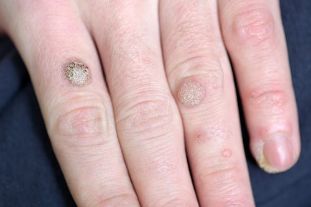
Definition of the disease. Causes of the disease
WartsIrregular, mild body benign skin lesions in the form of localized shrinkage of the upper layer of the skin (epidermis) with papules (lumps) or plaques.
The incidence of warts is 7-12% in adults and 10-20% in school-age children.
Warts are very similar to other skin growths. Usually, the person alone cannot pinpoint the disease, so a dermatologist should be consulted to make a diagnosis.
Warts are the human papillomavirus. The type of virus affects the type of warts that develop. Thus, all types of human papillomavirus infect tissue in the most typical localization.
| HPV type | Preferred localization |
Types of warts |
|---|---|---|
| 1 | Legs, knees, palms, hands, fingers |
Plant and palm warts, rarely simple warts |
| 2, 4 | Hands, fingers, knees, less commonly - legs |
Simple warts, occasional footwear, palmar and mosaic warts |
| 3, 10 | Hair, hands, face | Flat warts |
| 7 | Hands, fingers | Butcher wart |
| 5, 8, 9, 12, 14, 15, 17, 19-24 |
Face, arms, anterior torso |
Epidermodysplasia verruciform |
Infection with the virus usually occurs through contact - direct contact between infected and healthy skin (such as shaking hands) or indirectly (barriers, toys, etc. ). Therefore, it can be infected with the human papillomavirus, which is associated with warts, in a variety of places - public transportation, school, work, home, strong contact, and humid environments (swimming pools, saunas, gyms). The small trauma of the epidermis through which viruses enter and the inflammation of the skin contribute to the infection.
Also contributes to the appearance of warts:
- immunodeficiency (including HIV infection);
- warm and humid environment;
- the need for a professional relationship with meat and fish ("butcher's warts").
Certain types of human papillomavirus are spread by parents.
But toads and frogs - despite the horror stories we fear so often in childhood - are not contagious - this is one of the most popular myths about this disease, which has no basis.
If you get any of these symptoms, talk to your doctor. Do not heal yourself - dangerous to health!
wart symptoms
Symptoms vary depending on the type of wart.
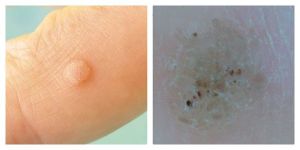
General Wart:
- Round, dense, normal-colored papule, at least 1-10 mm.
- The surface of the papula is covered with cracks and layers.
- If the papula is on your finger, the print will disappear and be distorted. The same goes for drawing the palm.
- Simple warts are located individually or within several pieces - usually at the site of the greatest injury (hands, fingers, knees).
- When viewed with a dermatoscope, the doctor may see small brown spots - thrombus (clogged) capillaries. Patients often refer to these points as "roots. "This is the main sign of a doctor: a dermatologist can use it to distinguish a wart from other similar diseases (such as molluscum contagiosum and keratoma).
Herbal (horny) wart:
- The main symptom that usually refers the patient to a doctor is pain when pressed and walking.
- Such warts are usually found on the legs.
- When you see a doctor, you will usually see a plainized, uneven plaque of the usual color, although in the first step you may see an even, smooth papule. With keratinization, capillaries are only visible when the keratinized layer of skin is removed.
- The skin of the sole is distorted.
- Plantation warts are usually solitary, but there are also 2-6 warts;
- These warts are often confused with corn (especially dry) - this is a description of a problem that patients usually visit.

Flat (juvenile) wart:
- Looks like a round, clean, smooth papaya, normal, pink or brown in color, 1-5 mm in size.
- Appears on your hand, shin, very often on your face.
- There are always several such warts - they are placed in groups.
Epidermodysplasia verruciform (senile wart):
- Large, round, numerous associated tumors of normal pink or brown color.
- Most commonly, the face, arms, and front of the torso appear to be confused with keratoma, shingles, and skin cancer.
wart pathogenesis
When it enters the body, the human papillomavirus can be in a latent state for a long time - one usually doesn’t even know it exists. When factors favorable to the virus appear, they begin to "multiply" in the epithelium, leading to tissue changes.
Unlike other viruses, the human papillomavirus does not destroy the cells of the epithelium itself - of course, they kill on their own during keratinization and flocculation.
The spread of infection is influenced by local factors and the state of the immune system. For example, people who are infected with HIV or have a kidney transplant are more likely to develop warts. Moreover, these tumors are often difficult to treat. With normal immunity, the virus does not affect the deep layers of the skin, so many people get warts on their own within a few months.
The main stage in the appearance of warts is to accelerate the rate of cell division and growth with the help of the virus. This rapid metabolism leads to thickening of the skin layers. As the tissues grow in a certain small area, a tuber appears called a wart.
Wart classification and developmental stages
There is no universally accepted classification for warts. However, there are several common versions:
- The most common warts(70% of warts are just them). Such tumors are not palpable and only cause aesthetic discomfort to humans.
- Herbal Wart- appears on the soles of the feet, is painful and therefore requires treatment. Skin trauma caused by uncomfortable, tight, worn shoes contributes to the development of such a wart.
- Flat warts- more common in young people and adolescents. This is due to the unstable hormonal background of young people, which affects the whole body. Usually flat warts are almost invisible.
- Senile warts- typical of the elderly. They often appear on the part of the body covered with clothing, but can occur on the face and hands. If there is no discomfort, these warts should not be treated - the healing of older people can be much slower than that of younger people due to their slow metabolism.
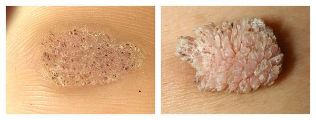
Other authors are even more different from these types of warts:
- Mosaic warts(HPV 2, 4) - tumors on the palms and soles of the feet. They look like foci of hyperkeratosis, i. e. , thickening of the cornea (usually in the front leg), covered with deep cracks.
- Cystic warts(HPV 60) is a very rare type of foot growth. It's a soft knot with cracks. When opened, a white-yellow discharge is similar to a clot.
- A filiform wartis a thin horny outgrowth near the mouth, nose or eyes.
- "Butcher" Wart(HPV 7) - Appears on the hands and fingers of people who are in constant contact with meat and fish. Cauliflower-like hypertrophic tumors are presented as normal in color.
In addition, wart types are distinguished depending on their location.
So anogenital warts, genital tumors that appear on the genitals (especially where the skin passes through the mucous membranes), are a common disease. It is usually caused by HPV types 6 and 11.
Complications of the wart
The main reason for wart patients to see a doctor is an aesthetic defect, which can affect the patient’s quality of life, self-confidence, and develop many complexes. Complications may include cracking of the wart surface and the addition of infection, as well as pain while walking in certain types of warts.
Skin tumors do not usually degenerate into malignancies, they are harmless, but in very rare cases, this complication can still occur in people with suppressed immunity.
Other complications occur when you try to remove the growth. In this regard, aesthetic defects in the form of inflammation and scarring, as well as the spread of the virus through the skin, can result in a person waking up with several new ones in the morning after a wart has cleared.
Keep in mind that keeping a wart underneath can hide a completely different disease that cannot be diagnosed without the advice of an experienced doctor.

wart diagnosis
Examination (clinical picture) and medical history (medical history) are usually sufficient to establish a diagnosis.
To confirm the diagnosis, your doctor may perform a histological examination - study of tumor cells.
It is very important to make a differential diagnosis - to differentiate warts from other diseases. For example,common wartsshould be distinguished from the following diseases:
- Molluscum contagiosum- appears more often in the body and genitals, less often in the hands and feet. It is a hemisphere on which the surface is indented; pressed from the side to release a whitish "glove".
- Epidermal wart nevus- more often lonely, has been present since birth. It rises above the surface of the skin, often covered with hair.
- Basal cell carcinoma- a tumor that develops in the form of a tumor spasm with a cortex in the center. Characteristic of older people.
Palmar-plantar wartsshould be distinguished from the following diseases:
- Keratoderma- large areas of keratinization and dermatitis. No coagulated capillaries.
- Palmar-planar syphilides- multiple painless tumors, the skin begins to peel along the periphery. The syphilis reaction is positive.
- Corn- usually painless, can only cause pain under vertical pressure.
Your doctor should also differentiate other types of warts from many diseases. If other pathologies are suspected, you may require additional diagnostics (such as antiviral antibody detection, CT, or MRI).
Wart treatment
Warts serve aesthetic purposes and improve the patient's quality of life. Only a doctor can prescribe after an examination and an accurately diagnosed diagnosis. Independent attempts to get rid of warts are unacceptable because a patient without medical training and the necessary equipment cannot pinpoint the disease, and complications after such "treatment" are much more common than cure.
There are several ways to treat warts. All are usually performed under the supervision of a physician and some are only performed in the clinic treatment room.
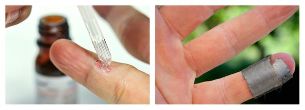
Chemical treatments
Milk salicylic collodion and salicylic patches are used to get rid of the wart. The percentage of drugs and how they are used (long-term wearing of plasters, applications, etc. ) depends on the prevalence and localization of tumors.
Solutions of zinc and 2-chloropropionic acid can also be used. In this case, a chemical composition is applied to the pretreated surface, which is left on the wart until the color changes (depending on the type of wart). The procedure was repeated several times after 7, 14 and 21 days. Before each procedure, the tissue is removed mechanically.
Another chemical method is a combination of nitric acid, acetic acid, oxalic acid, lactic acids and copper nitrate trihydrate. In this way, only relatively small tumors are treated - up to 5 mm. The solution is to change the color of the wart. After 3-5 days, the patient arrives for a follow-up appointment, prescribing a second procedure in 1-4 weeks if necessary.

Cryodestruction
This method involves freezing the wart with liquid nitrogen: a moistened swab should be pressed onto the damaged skin for 1-5 minutes (capturing the surrounding tissue a few mm). Some injuries take several weeks to destroy each other for four weeks
The main disadvantages of cryodestruction are pain and delayed effect compared to other methods where only one procedure is sufficient to remove them.
Electrocoagulation
Electric warts are removed in layers. Such surgery is performed under local anesthesia.
This method is more effective than cryodestruction, but has a significant drawback: electro-automation often leaves disadvantages at the site of wart removal. For patients who require cosmetic repair,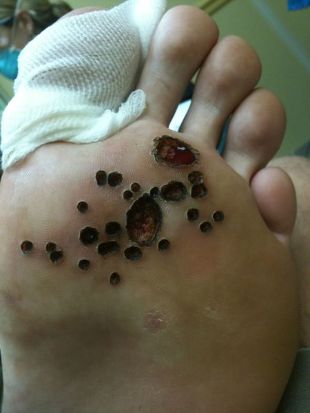 this method will not be the most appropriate.
this method will not be the most appropriate.
Laser Destruction
Also removes warts in laser layers. Depending on the size of the light guide, it comes in contact with the skin from a few seconds to three minutes. The cancer that appears is then excised and the bottom of the wound is lasered again. The patient is then learned to treat the wound. The surgery itself is performed under local anesthesia.
Radio wave surgery
Radio wave surgery is one of the most modern and gentle methods to remove some benign tumors, including warts.
The method is based on the generation of electromagnetic waves of different frequencies: 100 kHz to 105 MHz. During the process, the tissues resist the waves passing through, so the molecule releases energy into the cells, which warms the skin. Under the influence of heat, the cells actually evaporate - they get a proper cut. However, no mechanical forces are applied to the affected tissues.
The advantages of this method are
- security;
- rapid wound healing;
- good cosmetic effect - scars and scars don't matter;
- relative pain relief - local anesthetic is used before mini surgery;
- Exclude secondary infection due to automatic disinfection of the electrode when the device is turned on.
The effectiveness of this method is recognized worldwide, but it is quite difficult to find a clinic that uses the method of radio wave surgery.
Which treatment method to select
Each of the above methods has several disadvantages:
- For the first few weeks, the surgical area looks attractive - darkening of the crust, tissues. This should be taken into account if the warts are on visible parts of the body (such as the face).
- Unpleasant odor and some degree of pain during surgery.
In addition, these methods have contraindications that should be known through prior consultation with a dermatologist.
But the main disadvantage is the high probability of recurrence of, especially if the warts are widespread. With all these methods, doctors today do not fight the cause of the disease, but its consequences. human papillomavirus is incurable. xx / p>
Therefore, therapy is focused on:
- or destruction of tumors at the site of virus entry;
- or to stimulate an antiviral immune response;
- or a combination of these approaches.
Most destructive treatments are used. Their efficiency reaches 50-80%.
Childhood is generally not contraindicated in surgical treatments. Therefore, many of these (including radio wave surgery) are also used to treat warts in children. An exception is the chemical removal of warts due to the possibility of adverse reactions to the substance.
What to do after the operation
Be sure to follow your doctor's advice after performing the procedure.
After the neoplasm has been removed by any of the methods presented, your doctor will usually prescribe treatment for the removal site. Self-removal of the "bark", wetting of the wound and exposure to direct sunlight are prohibited.
If a patient has persistent warts, they should consult an immunologist - they may need medication to increase their immune resistance to human papillomavirus.
Forecast. Prevention
If a patient does not have an immune deficiency, the warts may go away on their own, but this will take a long time - from several months to several years. So in 65% of cases, the warts are self-contained within two years. If after two years the wart is still in place, it is recommended to remove it. It is recommended to remove multiple growths immediately.
With normal immunity and the appropriate removal method (depending on the size and type of wart), pathogenic tissues can be removed and a good cosmetic effect can be achieved. In case of decreased immunity and other predisposing factors, the human papillomavirus left in the body causes relapses.
There is no special disease prevention. But is infection inevitable?
You can reduce the likelihood of a virus by following a few rules:
- Avoid walking barefoot in public places where there is a risk of skin damage and viral infection (swimming pools, public showers, gyms).
- Choose quality footwear, change it often. Try to keep your feet dry. Heat and moisture are excellent breeding grounds for human papillomavirus.
- To avoid periungal warts, only consult an authorized nail technician and make sure sterile equipment is used.
To prevent anogenital warts, the WHO (World Health Organization) says that four paper-based vaccines are also very effective against the human papillomavirus. There are currently no vaccines available to prevent other types of warts.
If you find a wart, do not try to carbonize, cut or cut it with you - this may contribute to inflammation and further spread of the virus through the skin. After such a "removal", you can wake up with ten instead of a morning wart.














































































